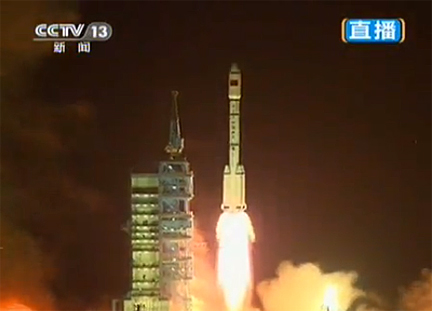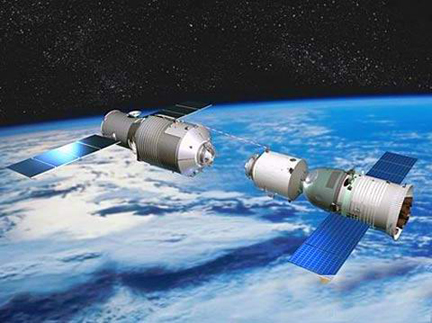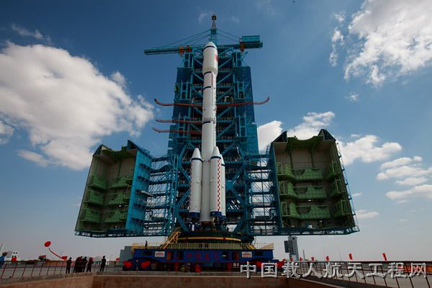China launches prototype lab module for rendezvous, docking tests
By WILLIAM HARWOOD
CBS News
In a major milestone for China's space program, a modified Long March 2 rocket boosted an unmanned prototype space station module, dubbed "Heavenly Palace," into orbit Thursday to serve as a target for critical tests of automated rendezvous and docking systems needed before construction of a Mir-class space station later in the decade,
The Long March 2F T1 rocket, equipped with four liquid-fueled strap-on boosters for extra launch power, took off from the Jiuquan Satellite Launch Center in north central China at 9:16 a.m. EDT (GMT-4; 9:16 p.m. local time), majestically climbing away through a clear night sky. The launching was carried live on Chinese television (YouTube video).
There were no obvious signs of trouble with the rocket or the Tiangong 1 spacecraft and cameras on the booster showed the space module separating as planned after reaching its planned preliminary orbit.
"The launch of Tiangong 1 has been successfully completed," Gen. Chang Wanquan, chief commander of China's manned space engineering project, told Chinese President Hu Jintao and other top government officials gathered at the Beijing Aerospace Command and Control Center. After a round of applause, Hu personally congratulated mission control personnel.
Launch of the Tiangong 1 spacecraft was the latest step in a slowly-but-steadily evolving manned space program aimed at building a 60-ton Chinese space station in low-Earth orbit.
"Step one was demonstration of human spaceflight capability," said Joan Johnson-Freese, a space policy analyst and an expert on the Chinese space program at the U.S. Naval War College. "Step two was basically developing capabilities for rendezvous and docking and step three is (building) a large space station. So, Tiangong is part of step two, it's to demonstrate docking and rendezvous.
"If you want to put it in analogous terms to the U.S. (space program), Mercury, Gemini and Apollo, they're about at Gemini. They're doing a lot of the technology testing."
The solar-powered Tiangong 1 spacecraft measures 34 feet long, 11 feet wide and weighs 8.5 tons, featuring a pressurized volume of 530 cubic feet, "which can satisfy three astronauts," according to a spokeswoman for the China Manned Space Engineering Project. It features a pressurized experiment module where visiting crews can live and work and a "resource module" housing electrical power, propulsion and life support systems.
For comparison, the International Space Station operated by the United States, Russia, Europe, Canada and Japan, is the size of a football field, weighs more than 450 tons and has a pressurized volume comparable to a 747 jumbo jet. It has been staffed with rotating crews of up to six astronauts and cosmonauts for more than 11 years.
But the Tiangong project, expected to operate for about two years, is a major step forward for the Chinese and a clear sign of things to come.
Flight controllers plan to maneuver the Tiangong 1 spacecraft into a near-circular 213-mile-high orbit. If all goes well, an unmanned ferry craft, Shenzhou 8, will be launched in mid November on a mission to automatically rendezvous and dock with the outpost. The rendezvous is expected to take two days and the Shenzhou will spend 12 days docked with Tiangong 1 before departing and returning to Earth.
If that flight goes well, the Chinese may press ahead with launch of a manned mission using the Shenzhou 9 spacecraft next year. If any issues develop with the initial mission, however, a second unmanned flight could be launched before putting a crew aboard the Shenzhou 10 vehicle.
The Tiangong-Shenzhou test flights are "a big deal to the Chinese public," said Gregory Kulacki, a senior analyst with the Global Security Program of the Union of Concerned Scientists.
"I think it's a big deal for the Chinese government, I think it's obviously a major step forward for the aerospace program," he said in an interview. "There's a lot of excitement in the community for being able to do something like this. The autonomous rendezvous and docking that they're going to do with this module ... that'll be quite an accomplishment."
After a series of unmanned test flights, China became the third nation, after the United States and the Soviet Union/Russia, to launch a manned spacecraft in October 2003 when Yang Liwei blasted off aboard the Shenzhou 5 spacecraft. Shenzhou 6, carrying two crew members, was successfully launched in October 2005 and Shenzhou 7, carrying a three-man crew, flew in September 2008.
Kulacki said the Chinese are committed to building a large, independently operated space station by the early 2020s.
"They're very serious about the program, which started in response to Ronald Reagan's 'Star Wars' speech in March of '83," he said. "Three years after that, in response to a letter from four Chinese scientists, this process got underway. A lot of people had doubts about it in the beginning, and it wasn't until 1991 that they actually funded the program.
"But once they made that commitment, they've been pretty solid with it and they seem to be proceeding according to a plan that's decades old. While they're going a bit slower than they originally envisioned, they seem to be all in."
The Chinese have not announced any long-term goals beyond the construction of a space station, although eventual manned lunar missions are a possibility. While Chinese leaders and the Obama administration have expressed interest in cooperating on the high frontier, U.S. lawmakers have resisted any meaningful discussion.
"Within China, there is debate about this as well," Kulacki said. "Many people in the Chinese aerospace community believe it's better for China not to cooperate because it allows them to proceed very systematically, step by step, on their own. If they were part of a cooperative project in human spaceflight, that would obviously have implications for the course of their own program."
CBS News
In a major milestone for China's space program, a modified Long March 2 rocket boosted an unmanned prototype space station module, dubbed "Heavenly Palace," into orbit Thursday to serve as a target for critical tests of automated rendezvous and docking systems needed before construction of a Mir-class space station later in the decade,
 |
| A Long March 2F T1 rocket climbs away from the Jiuquan Satellite Launch Center Thursday, boosting a prototype Chinese space station module into orbit. (Credit: CCTV News) |
 |
| An artist's impression of the Tiangong 1 space station module, left, with a Shenzhou crew ferry craft on final approach for docking. (Credit: China Manned Space Engineering Project) |
"The launch of Tiangong 1 has been successfully completed," Gen. Chang Wanquan, chief commander of China's manned space engineering project, told Chinese President Hu Jintao and other top government officials gathered at the Beijing Aerospace Command and Control Center. After a round of applause, Hu personally congratulated mission control personnel.
Launch of the Tiangong 1 spacecraft was the latest step in a slowly-but-steadily evolving manned space program aimed at building a 60-ton Chinese space station in low-Earth orbit.
"Step one was demonstration of human spaceflight capability," said Joan Johnson-Freese, a space policy analyst and an expert on the Chinese space program at the U.S. Naval War College. "Step two was basically developing capabilities for rendezvous and docking and step three is (building) a large space station. So, Tiangong is part of step two, it's to demonstrate docking and rendezvous.
"If you want to put it in analogous terms to the U.S. (space program), Mercury, Gemini and Apollo, they're about at Gemini. They're doing a lot of the technology testing."
The solar-powered Tiangong 1 spacecraft measures 34 feet long, 11 feet wide and weighs 8.5 tons, featuring a pressurized volume of 530 cubic feet, "which can satisfy three astronauts," according to a spokeswoman for the China Manned Space Engineering Project. It features a pressurized experiment module where visiting crews can live and work and a "resource module" housing electrical power, propulsion and life support systems.
For comparison, the International Space Station operated by the United States, Russia, Europe, Canada and Japan, is the size of a football field, weighs more than 450 tons and has a pressurized volume comparable to a 747 jumbo jet. It has been staffed with rotating crews of up to six astronauts and cosmonauts for more than 11 years.
But the Tiangong project, expected to operate for about two years, is a major step forward for the Chinese and a clear sign of things to come.
 |
| The Long March 2F T1 rocket during preparations to launch China's Tiangong-1 space station target module. (Credit: China Manned Space Engineering Project) |
If that flight goes well, the Chinese may press ahead with launch of a manned mission using the Shenzhou 9 spacecraft next year. If any issues develop with the initial mission, however, a second unmanned flight could be launched before putting a crew aboard the Shenzhou 10 vehicle.
The Tiangong-Shenzhou test flights are "a big deal to the Chinese public," said Gregory Kulacki, a senior analyst with the Global Security Program of the Union of Concerned Scientists.
"I think it's a big deal for the Chinese government, I think it's obviously a major step forward for the aerospace program," he said in an interview. "There's a lot of excitement in the community for being able to do something like this. The autonomous rendezvous and docking that they're going to do with this module ... that'll be quite an accomplishment."
After a series of unmanned test flights, China became the third nation, after the United States and the Soviet Union/Russia, to launch a manned spacecraft in October 2003 when Yang Liwei blasted off aboard the Shenzhou 5 spacecraft. Shenzhou 6, carrying two crew members, was successfully launched in October 2005 and Shenzhou 7, carrying a three-man crew, flew in September 2008.
Kulacki said the Chinese are committed to building a large, independently operated space station by the early 2020s.
"They're very serious about the program, which started in response to Ronald Reagan's 'Star Wars' speech in March of '83," he said. "Three years after that, in response to a letter from four Chinese scientists, this process got underway. A lot of people had doubts about it in the beginning, and it wasn't until 1991 that they actually funded the program.
"But once they made that commitment, they've been pretty solid with it and they seem to be proceeding according to a plan that's decades old. While they're going a bit slower than they originally envisioned, they seem to be all in."
The Chinese have not announced any long-term goals beyond the construction of a space station, although eventual manned lunar missions are a possibility. While Chinese leaders and the Obama administration have expressed interest in cooperating on the high frontier, U.S. lawmakers have resisted any meaningful discussion.
"Within China, there is debate about this as well," Kulacki said. "Many people in the Chinese aerospace community believe it's better for China not to cooperate because it allows them to proceed very systematically, step by step, on their own. If they were part of a cooperative project in human spaceflight, that would obviously have implications for the course of their own program."